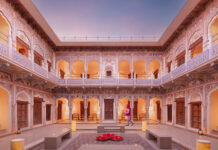—NYC & Company Invites Travelers and Locals Alike to Experience Staten Island, From Beautiful Parks and Historic Sites to Excellent Food and Fun for Kids, As Part of New Get Local NYC Campaign—
—Take the Ferry or Travel by Car and Spend the Day on Staten Island Dining, Shopping, Sightseeing, and Enjoying Parks, Beaches, the Zoo, Museums and More—
New York City (July 14, 2022) — NYC & Company, New York City’s official destination marketing organization and convention and visitors bureau for the five boroughs of New York City, invites locals and visitors alike to Staten Island Like a New Yorker as part of the organization’s Get Local NYC initiative.
Go by ferry or car and plan a day of shopping, dining and sightseeing, from museums and historic sites to parks, beaches and gardens. Kids will love the Staten Island Zoo and Children’s Museum. History buffs will want to see the Conference House, where Ben Franklin and John Adams tried to broker peace with the British in 1776. Baseball fans will want to catch a game with the FerryHawks while enjoying stupendous views of the Manhattan skyline across New York Harbor. Cool off with a treat from Ralph’s Famous Italian Ices, pick up Italian pastries at Royal Crown Bakery, head to Lee’s Tavern for pizza and a beer, or try Sri Lankan food at New Asha.
Other unique points of interest on Staten Island include the Chinese Scholar’s Garden at Snug Harbor; the National Lighthouse Museum; the Jacques Marchais Museum of Tibetan Art; and the home of pioneering photographer Alice Austen, a New York City LGBTQ+ historic site. Visitors can also see the farm where Frederick Law Olmsted experimented with landscaping before designing Central Park; the 19th-century African American community called Sandy Ground; and Historic Richmond Town, a village dating to the late 17th century. Admirers of the Catholic activist Dorothy Day, who devoted her life to serving the poor, can pay respects at her gravesite and explore the remnants of the bungalow beach community where she lived.
“Staten Island is home to an incredible variety of historical sites, attractions for families, cultural enclaves, and beautiful areas to enjoy nature, whether biking, birdwatching, or relaxing on a quiet beach,” said NYC & Company President and CEO Fred Dixon. “In Staten Island, you can walk in the footsteps of Founding Father Ben Franklin and Central Park designer Frederick Law Olmsted, or try authentic Sri Lankan food for lunch and Italian prepared family style for dinner. From the Snug Harbor Cultural Center to the new Empire Outlets mall right by the ferry, Staten Island has something for all visitors.”
GETTING THERE AND GETTING AROUND
Two ferry services connect Manhattan and Staten Island. There’s a free ferry from the Whitehall Ferry Terminal in Lower Manhattan (take the R train to Whitehall, the 4 or 5 to Bowling Green, or the 1 to South Ferry), or take a NYC Ferry ($2.75) from either of two Manhattan departure points: Midtown West/Pier 79 (near West 39th Street) and Battery Park City (follow Vesey Street west to the river in Lower Manhattan). Both ferries dock at the St. George terminal on the Staten Island side. From there, it’s a short walk to the Empire Outlets mall, the St. George Theatre and the FerryHawks baseball stadium.
From the ferry terminal, visitors can catch buses to any number of attractions, pick up taxis or rideshares, or even hop on the Staten Island Railway, an aboveground train that runs from St. George on the island’s North Shore all the way to Tottenville on the South Shore. The same MetroCard used on subways and buses in NYC’s other boroughs works for buses and the railway on Staten Island. Contactless credit/debit cards and digital payments (like Apple Pay) are also accepted.
By car, visitors can reach Staten Island via one of four bridges: the Verrazzano-Narrows Bridge connecting the island to Brooklyn, or the Bayonne Bridge, Goethals Bridge or Outerbridge Crossing, which links the island to New Jersey.
Express buses run to Staten Island from Manhattan and Bay Ridge, Brooklyn.
Hotel options on Staten Island include the Fairfield Inn & Suites, Hampton Inn & Suites and the Hilton Garden Inn.
The Hilton, located on a 415-acre protected woodland, offers a 10-story tower with panoramic views; two ballrooms for special events; Lorenzo’s Restaurant & Cabaret, which has a Sunday jazz brunch, live music on Friday and Saturday nights and upscale Italian fare; and the indoor/outdoor venue Above, a rooftop nightclub and ballroom.
GREEN SPACE AND BEACHES
Staten Island is blessed with 10,000 acres of parks and green spaces, plus miles of beaches, boardwalks and waterfront views.
Nearly a third of the island’s green space consists of forests, wetlands, lakes, ponds and hiking trails linked together in the Staten Island Greenbelt. Greenbelt locations include La Tourette Park Golf Course, the William T. Davis Wildlife Refuge and bird sanctuary, Reed’s Basket Willow Swamp Park, Willowbrook Park and Greenbelt headquarters at the High Rock Environmental Center.
Staten Island is also home to several National Park Service sites within the Gateway National Recreation Area. They are Great Kills Park, which has a lifeguarded beach, hiking and biking trails, fishing areas, a marina and boat launch; Miller Field, a former military airfield with baseball, cricket, softball and soccer fields; and Fort Wadsworth, one of the oldest military installations in the nation, offering breathtaking views of New York Harbor.
The bike-friendly 2.5-mile Franklin D. Roosevelt Boardwalk runs from Fort Wadsworth to Miller Field. The boardwalk provides access to two of the island’s most popular Atlantic Ocean beaches, South Beach (look for the fountain with six bronze dolphins) and Midland Beach. Amenities include a skate park, fishing pier and playgrounds.
Staten Island has more than 60 neighborhoods scattered across 60 square miles. It is more suburban than most of NYC, with the fewest residents of any of the five boroughs (population 500,000). It also has the highest percentage of people who own their own homes (66%) and the fewest tall buildings (20 stories is as high as it gets on Staten Island).
Here are details on some of the Island’s attractions, restaurants and places to shop, organized by location.
Take the ferry to St. George and enjoy views of the Manhattan skyline from the North Shore Waterfront Esplanade. Look for Postcards, a stirring memorial to the 275 Staten Islanders who perished on September 11, 2001. The National Lighthouse Museum is walking distance from the ferry, as is the ballpark where the minor-league FerryHawks baseball team plays. Go for the views as much as for the game, hot dogs and beer. Or choose from more than 70 types of beer at the Flagship Brewing Co., less than a mile away.
Next to the ferry terminal is the City’s only outlet shopping mall, Empire Outlets. Stores include Nordstrom Rack, Patterns & Dots, Cotton On, Lids, Nike, Banana Republic, Gap, H&M, Old Navy, Parfum Europa, Samsonite, iOptics and Guess. The mall’s inviting outdoor spaces, fun food trucks and waterfront vistas make it a great place to spend the afternoon. Don’t miss Clinton Hall, an airy outdoor bar on an upper level with swings and games like Jenga and cornhole. On-site stores can validate parking passes for the mall’s indoor parking lot.
The nearby St. George Theatre opened in 1929 as a grand movie-and-vaudeville house. It has been used as a location for movies like The School of Rock and TV shows like Gossip Girl. The theater has hosted everyone from Al Jolson to Jerry Seinfeld. Shows scheduled for 2022 included Melissa Etheridge and Paul Anka.
Dining options in the area include Pier 76 (go for the thin-crust pizza) and Enoteca Maria, which features real grandmothers’ cooking from their native cuisine on a rotating schedule. For those into classic comic books, Hypno-Tronic Comics is a must.
WEST NEW BRIGHTON, WEST BRIGHTON AND RANDALL MANOR
The Snug Harbor Cultural Center & Botanical Garden is about two miles north of the ferry terminal along the island’s North Shore in the West New Brighton neighborhood (20 minutes via the S40, S44 or S46 bus lines). Snug Harbor was founded in the 19th century as a retirement home for sailors; five of its original Greek Revival buildings are city landmarks. The complex includes a concert hall, the Newhouse Center for Contemporary Art, the Staten Island Museum, the Noble Maritime Collection and 14 themed gardens. Among the most popular attractions are the Chinese Scholar’s Garden and the Staten Island Children’s Museum.
The Staten Island Zoo, about two miles from Snug Harbor, is home to Staten Island Chuck, a groundhog called upon every Groundhog Day to forecast whether spring will come early. The zoo’s collection also includes sheep, goats, leopards, lemurs, meerkats and sloths, but it’s best-known for its snakes, including one of the country’s most complete collections of rattlesnakes.
Also nearby are Clove Lakes Park, Silver Lake Park, the Silver Lake Golf Course and the Italian Cultural Foundation at Casa Belvedere, which hosts exhibitions, cooking classes, sunset yoga, festivals, live performances and more. Egger’s Ice Cream Parlor is a mile from the zoo on Forest Avenue, where it’s been serving up sweet treats since 1964. The legendary Ralph’s Famous Italian Ices has several locations, including the original on Port Richmond Avenue; be prepared to wait on a line stretching down the block.
ROSEBANK AND LITTLE SRI LANKA
The Alice Austen House Museum is in the Rosebank neighborhood, about two and a half miles south of the ferry terminal (reachable via the S51, S78 and S76 bus lines or the Staten Island Railway). The museum documents the life and work of Alice Austen, a pioneering photographer and important figure in NYC’s LGBTQ+ history. She lived for 30 years with another woman, Gertrude Tate, and many of her photos portray intimacy between Victorian women. Her documentary-style images also captured immigrant life, nature and architecture in the late 19th and early 20th centuries. The Austen site is a charming Victorian Gothic cottage in a shorefront park near the Verrazzano-Narrows Bridge with sweeping views of Brooklyn and Lower Manhattan. The museum hosts exhibitions of contemporary photography as well.
Rosebank is also home to the Garibaldi-Meucci Museum, located in the 1840 house where telephone inventor Antonio Meucci gave refuge to the revolutionary Italian patriot Giuseppe Garibaldi and his wife. Garibaldi returned to Italy in 1850 to head the military campaign that led to the unification of Italy.
Staten Island’s “Little Sri Lanka” community is clustered in two neighborhoods between the ferry terminal and the Austen House, Tompkinsville and Stapleton. Two dining spots, Lakruwana and New Asha, are routinely included on lists of New York foodie favorites. Lakruwana, a sit-down restaurant decorated with Buddhist-themed artwork, offers a popular weekend buffet. New Asha is a friendly hole in the wall; whatever the proprietor is dishing from hot trays is guaranteed to be delicious. Also in Tompkinsville is the Sri Lankan Art & Cultural Museum.
FORT WADSWORTH AND THE SOUTH SHORE BEACHES
Continuing south along the waterfront, headquarters for Staten Island’s Gateway National Recreation Area are about a mile from the Austen House (reachable via the S51 bus). The Gateway complex includes historic Fort Wadsworth. The Franklin Delano Roosevelt Boardwalk is adjacent to the park and runs for two miles along the shore, to South Beach and Midland Beach. The boardwalk ends at Miller Field.
ELTINGVILLE, ANNADALE, ROSSVILLE
Head southwest along the waterfront for Great Kills Park, Great Kills Beach, and Wolfe’s Pond Park. This section of Staten Island is also where two of the island’s most famous residents once lived: Frederick Law Olmsted and Dorothy Day.
Olmsted acquired 130 acres of woods and farmland in 1848 in the Eltingville neighborhood, including a stone house that was built in 1685 on a bluff overlooking Raritan Bay. Olmsted called the property Tosomock Farm, and he lived there for seven years. He ran a farm and a nursery, and honed the landscaping skills he would later use to design Central Park. Visitors can still see some of the trees Olmsted planted nearly 175 years ago. Walk down to the water a short distance from the house for a peaceful view on a secluded beach. About a mile inland is the Italian restaurant Campania, one of several spots where Kim Kardashian dined with her then boyfriend Pete Davidson, a Staten Island native and former SNL cast member.
A mile and a half from the Olmsted farm is a rugged but beautiful waterfront stretch that was once home to a bohemian bungalow colony called Spanish Camp. Its residents included the Catholic activist Dorothy Day, who founded the Catholic Worker Movement and devoted her life to serving the poor. Day died in 1980, and her home and other cottages were torn down in 2001. Remnants of several bungalows can still be found by following the path to the beach from the Spanish Camp street sign. Visitors who want to pay their respects to Day can find her grave at Resurrection Cemetery. Her plain, flat tombstone (located in Section 1 diagonally across from the parking lot at 361 Sharrott Ave.) is decorated with a miniature American flag, flowers, small religious figures and the words “Deo Gratias,” Latin for thanks to God.
Another chapter of Staten Island history can be found two and a half miles north of the cemetery in the Rossville neighborhood. Here lies Sandy Ground, which calls itself the oldest continuously inhabited free Black settlement in the US. An African American man first purchased land here in the late 1820s and others settled here in the 1840s, moving in from Maryland’s Chesapeake Bay area. Rossville AME Zion Church was founded in 1850 and served as a stop on the Underground Railroad during the Civil War. The original cemetery still exists with more than 30 marked graves. Historic homes include the Reverend Isaac Coleman and Rebecca Gray Coleman House, and the Baymen’s Cottages, which housed workers in the oyster trade. The Sandy Ground Historical Museum tells the community’s story. Clay Pit Ponds State Park Preserve is nearby.
LIGHTHOUSE HILL
A drive around Lighthouse Hill’s steep and winding roads offers a glimpse of some of Staten Island’s most interesting architecture. The Jacques Marchais Museum of Tibetan Art was designed to resemble a Tibetan mountain monastery. Founded and designed by an American woman who was a Tibetan art collector, Jacques Marchais, the museum hosts meditations, performances and other events. Less than a mile away is The Crimson Beech, the only home in NYC designed by Frank Lloyd Wright (it is privately owned but can be glimpsed from the road). And yes, Lighthouse Hill has a lighthouse: the Staten Island Range Light, a whimsical red-topped octagonal structure built in 1912 that’s 90 feet tall and 145 feet above sea level.
Historic Richmond Town tells the story of 350 years of life on Staten Island. Richmond Town was the original county seat for Staten Island (which is also known as Richmond County). Its preserved sites include a courthouse, church, jail, tavern, cemetery and homes. Visitors can take guided tours, interact with costumed interpreters and see demonstrations of crafts and skills like blacksmithing. Programming includes concerts and festivals. Decker Farm, which dates to 1810 and is considered NYC’s oldest continuously working family farm, is a mile away.
Nearby Richmond Town are the Greenbelt Nature Center, High Rock Park and La Tourette Park. Just south of La Tourette in the Great Kills section is Atrium Stadium Cinemas, which hosted Kim Kardashian and Pete Davidson for a screening of House of Gucci. North of La Tourette is the Staten Island Mall.
TOTTENVILLE
Tottenville is located on Staten Island’s southwestern tip, as far from the ferry as any point on the island (but reachable via the Staten Island Railway). It’s worth the trek, especially for anyone interested in American history.
The Conference House, a grand stone manor house built in 1680, is the second-oldest building in New York City. It’s named for a peace conference held there on September 11, 1776, just a few months after the start of the Revolutionary War between England and the American colonies. Founding Fathers John Adams and Ben Franklin met with King George’s representative, Lord Richard Howe, but the Americans were only authorized to negotiate terms that included independence for the colonies, and the British would not concede that point.
The house is located in a stunning waterfront park with a pavilion and breathtaking views of Raritan Bay. The park includes three miles of shoreline and six miles of hiking trails, plus the Conference House Visitors Center and several other historic homes: the Rutan-Becket House, the Ward-Leven House and the Henry Hogg Biddle House. Do not miss Alice’s Garden at the Biddle House, a charming site dedicated to artisans of Tottenville’s Atlantic Terra Cotta Co. The company was one of the largest producers of architectural terra-cotta in the US, and it once operated a factory on Staten Island. The garden includes samples of its work.
Also in Tottenville: Staten Island’s favorite beer hall, Killmeyer’s Old Bavaria Inn, and the elegant Italian dining spot Angelina’s Ristorante, which has seen a surge in popularity since you-know-who stopped by—Kim Kardashian.
For further information on exploring Staten Island, visit nycgo.com/statenisland.





















